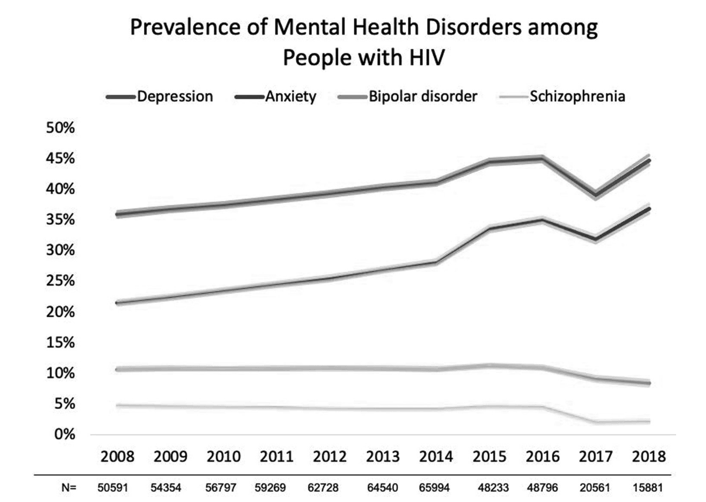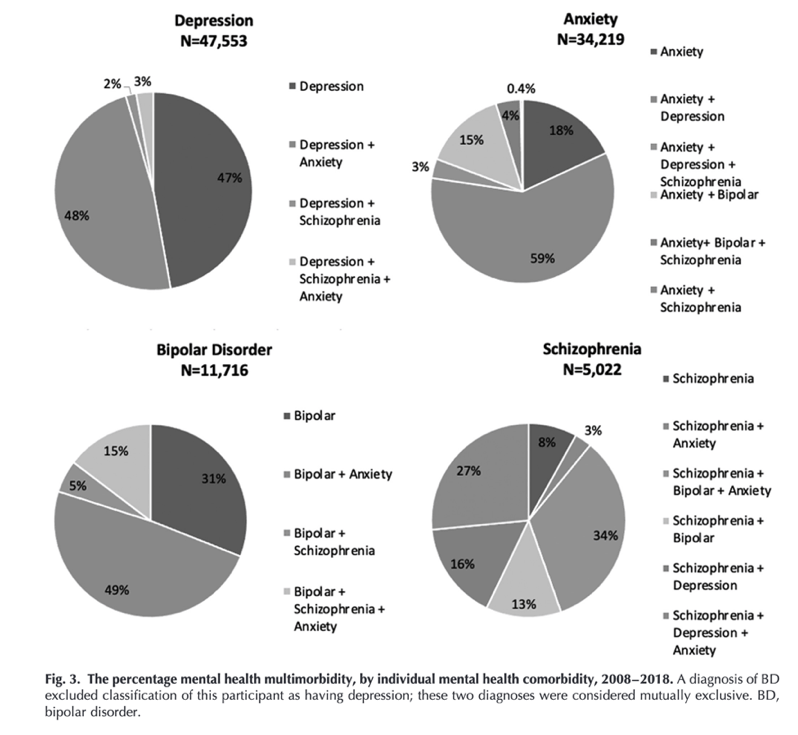| |
The prevalence of mental health disorders (55% and increasing)
in people with HIV and the effects on the HIV care continuun
|
| |
| |
Download the PDF here
Lang, Raynella,b; Hogan, Brennaa; Zhu, Jiafengc; McArthur, Kristenc; Lee, Jennifera; Zandi, Peterd; Nestadt, Pauld; Silverberg, Michael J.e; Parcesepe, Angela M.f; Cook, Judith A.g; Gill, M. Johnb; Grelotti, Davidh; Closson, Kalyshai; Lima, Viviane D.j; Goulet, Josephk; Horberg, Michael A.l; Gebo, Kelly A.m; Camoens, Reena M.n; Rebeiro, Peter F.o; Nijhawan, Ank E.p; McGinnis, Kathleenq; Eron, Josephr; Althoff, Keri N.a
Feb 1 2023
The prevalence of mental health disorders -MHD among PWH was high (55%), including MH multimorbidity.....affects care continuum
Among 122 896 PWH, 67 643 (55.1%) were diagnosed with one or more mental health disorders (MHD): 39% with depressive disorders, 28% with anxiety disorders, 10% with bipolar disorder, and 5% with schizophrenia.
The prevalence of depressive and anxiety disorders increased between 2008 and 2018, whereas bipolar disorder and schizophrenia remained stable. MH multimorbidity affected 24% of PWH.
Combining HIV and MHDs care visits provides added convenience and incentive and may increase access to both types of care.
Due to the high prevalence of MHDs and multimorbidity among PWH, clinicians must remain vigilant with screening for these disorders and providing effective engagement into MH services when needed.
Our findings highlight the success of HIV care programs to provide PWH with both HIV and MH treatment, but also the ongoing need for improved resources for MH screening, linkage to treatment, and support programs to eliminate the identified gaps. The importance of MH services being integrated into HIV care programs has been emphasized through the COVID-19 pandemic as reports suggest increasing prevalence and worsening symptoms of MHDs [53,54].
Fig. 1. Prevalence (and 95% confidence intervals represented by the lighter color shade) of mental health disorders, 2008-2018.


Abstract
Objective:
To describe the prevalence of diagnosed depression, anxiety, bipolar disorder, and schizophrenia in people with HIV (PWH) and the differences in HIV care continuum outcomes in those with and without mental health disorders (MHDs).
Design:
Observational study of participants in the North American AIDS Cohort Collaboration on Research and Design.
Methods:
PWH (≥18 years) contributed data on prevalent schizophrenia, anxiety, depressive, and bipolar disorders from 2008 to 2018 based on International Classification of Diseases code mapping. Mental health (MH) multimorbidity was defined as having two or more MHD. Log binomial models with generalized estimating equations estimated adjusted prevalence ratios (aPR) and 95% confidence intervals for retention in care (≥1 visit/year) and viral suppression (HIV RNA ≤200 copies/ml) by presence vs. absence of each MHD between 2016 and 2018.
Results:
Among 122 896 PWH, 67 643 (55.1%) were diagnosed with one or more MHD:
39% with depressive disorders, 28% with anxiety disorders, 10% with bipolar disorder, and 5% with schizophrenia.
The prevalence of depressive and anxiety disorders increased between 2008 and 2018,
whereas bipolar disorder and schizophrenia remained stable.
MH multimorbidity affected 24% of PWH.
From 2016 to 2018 (N = 64 684), retention in care was marginally lower among PWH with depression or anxiety, however those with MH multimorbidity were more likely to be retained in care.
PWH with bipolar disorder had marginally lower prevalence of viral suppression (aPR = 0.98 [0.98-0.99]) as did PWH with MH multimorbidity (aPR = 0.99 [0.99-1.00]) compared with PWH without MHD.
Conclusion:
The prevalence of MHD among PWH was high, including MH multimorbidity. Although retention and viral suppression were similar to people without MHD, viral suppression was lower in those with bipolar disorder and MH multimorbidity.
|
|
| |
| |
|
|
|